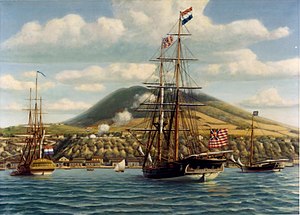USS Andrew Doria (1775)

Andrew Doria receives a salute from the Dutch fort at Sint Eustatius, 16 November 1776.
|
|
| History | |
|---|---|
|
|
|
| Name: | Andrew Doria |
| Namesake: | Andrea Doria |
| Acquired: | November 1775 |
| Nickname(s): | "Black Brig" |
| Fate: | Scuttled in the Delaware River, November 1777 |
| Notes: | Formerly merchant brig Defiance |
| General characteristics | |
| Type: | Brig |
| Displacement: | 190 long tons (190 t) |
| Length: | 75 ft (23 m) |
| Beam: | 25 ft (7.6 m) |
| Depth: | 10 ft (3.0 m) |
| Complement: | 112 officers and men |
| Armament: | 14 × 4-pounder (1.8 kg) guns |
| Service record | |
| Commanders: |
|
| Operations: | |
Andrew Doria was a brig purchased by the Continental Congress in November 1775. She is most famous for her participation in the Battle of Nassau—the first amphibious engagement by the Continental Navy and the Continental Marines—and for being the first United States vessel to receive a salute from a foreign power.
On 13 October 1775, the Continental Congress authorized the purchase of the merchant brig Defiance. The ship was acquired in mid-November and moored in Wharton and Humphreys shipyard in Philadelphia where she was converted into a warship by Joshua Humphreys (hull strengthening), John Barry (re-rigging), and John Falconer (ordnance and provisioning) at a cost of £296.4s.6d. She was named Andrew Doria after the 16th-century Genoese admiral Andrea Doria. Under the command of Captain Nicholas Biddle, Andrew Doria departed Philadelphia on 4 January 1776, as a warship in Esek Hopkins' small fleet of five newly fitted warships (Alfred, Andrew Doria, Cabot, Columbus, and Providence), bound for the Chesapeake Bay. Between 11 and 17 February, the fleet was joined by the small sloop Fly, the sloop Hornet, and the schooner Wasp.
...
Wikipedia
